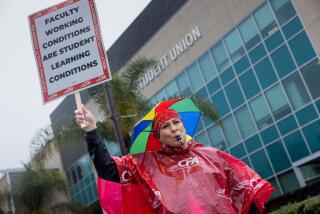Nation’s College Teachers Fed Up With the Need to ‘Publish or Perish’
- Share via
The need to “publish or perish” is taking its toll on the nation’s college professors, most of whom prefer to spend their time teaching but feel compelled to conduct research to earn promotions and tenure, according to a survey by the Carnegie Foundation for the Advancement of Teaching.
The two-year survey of 5,000 college and university faculty members showed that the interests of 69% of those at public institutions and 73% of those at private universities “lie toward teaching, not research.” A startling 39% of the faculty members at research institutions--universities whose primary mission is scholarly and scientific research--agreed with the statement.
“While research and publication are viewed as the primary route to tenure and promotion, still most faculty (members) say teaching matters most, and still most faculty (members) are frustrated” by the conflict, said Ernest Boyer, president of the Carnegie Foundation at Princeton University.
But despite that situation and salaries deemed only “fair or poor” by about 60% of those surveyed, 80% of the faculty members interviewed said they would choose higher education teaching careers again and 60% described themselves as “more enthusiastic” than when they began.
That is primarily because of the respect afforded college teachers, Boyer said. “There still is an aura of acceptance in the culture that is enormously important,” he said. Those feelings of respect contrast markedly with the low status afforded elementary- and secondary-school teachers, he said.
The tone of Boyer’s address differed sharply from his description of the survey results in an Aug. 18 article he wrote for the New York Times, in which he said that “college faculty members are deeply troubled and anxious about their current status and prospects for the future.”
In that report, Boyer said that “40% of the faculty members surveyed said they were less enthusiastic about their work now than when they began their careers,” 30% said they felt “trapped,” and more than half would seriously consider a non-academic opportunity if one came along.
Boyer, who will include the data in his book “College: The Undergraduate Experience in America,” to be published in the fall, said the conflict between teaching and research creates a “curious ambivalence that is not healthy for either the institution or the people.”
One effect of the conflict is that teachers simply avoid scholarly research: 33% to 50% of the faculty members outside research institutions told the pollsters they were doing no research. Another effect is the production of “pseudo-research” and “pseudo-journals” intended to fulfill requirements to publish, Boyer said.
Students, Boyer said, recognize when they are being shortchanged: 45% of public university students and 23% of those in private schools said that “most students here are treated like numbers in a book.” The feeling was strongest in research institutions, where 62% agreed, weakest at liberal arts colleges, where only 9% agreed.
Boyer, one of the nation’s leading education experts and author of the acclaimed 1983 study “High School: A Report on Secondary Education in America,” spoke Monday to the annual meeting of the Assn. of Governing Boards of Universities and Colleges. He called on the 27,000 trustees, regents and chancellors who are members of the organization to begin prizing teaching as highly as research.
“If we do not find ways to honor teaching, we will continue to have frustration among parents, faculty and students,” Boyer told his audience at the Sheraton Harbor Island East hotel.
The survey showed that 64% of public university teachers and 70% of those in private schools believe that “teaching effectiveness, not publication, should be the primary criteria for promotion.” The statement was supported by 35% of the faculty at research institutions, 83% at liberal arts schools, and 88% at two-year schools.
Boyer and Clark Kerr, president emeritus at the University of California, later conceded that such a teaching evaluation system has been perennially difficult to establish because research papers are tangible, quantifiable evidence of a professor’s performance while teaching skills can only be judged subjectively.
But Boyer, who teaches at Princeton University’s Woodrow Wilson School of Public and International Affairs, said students there send evaluations directly to department deans, who deny tenure to professors who are judged to be poor teachers.
The study revealed that 61% of the faculty at public institutions and 58% of those at private universities rated their salaries as “fair or poor.” It found that salaries were particularly low at liberal arts colleges, where 57% of the teachers earn less than $25,000 a year.
The survey also found an unexpectedly high acceptance of collective bargaining on campuses, a concept that Boyer said was “unthinkable” just 30 years ago. On public university campuses, 64% of the faculty said that “collective bargaining has a place in higher education.” The idea was supported by 61% of private school teachers.
Collective bargaining won support among more women than men and was particularly popular with younger instructors, who have grown up with it as a way of life. Seventy percent of the teachers under age 36 endorsed collective bargaining, while 57% of those over 57 supported it.
Women also showed the most skepticism about tenure, the practice of awarding a faculty member lifetime employment upon fulfillment of certain requirements. Forty-three percent of the women polled agreed that “the abolition of tenure would improve higher education,” a concept that was endorsed by only 33% of the men questioned.
Boyer suggested that the results reflected women faculty members’ suspicions that tenure--often granted by departmental colleagues--is a product of the “old-boy network” from which they have historically been excluded.
More to Read
Sign up for Essential California
The most important California stories and recommendations in your inbox every morning.
You may occasionally receive promotional content from the Los Angeles Times.










